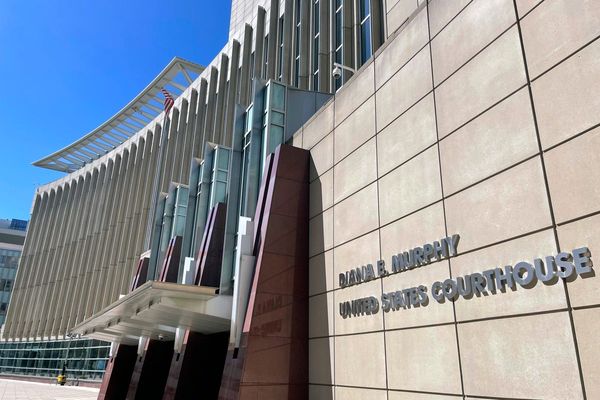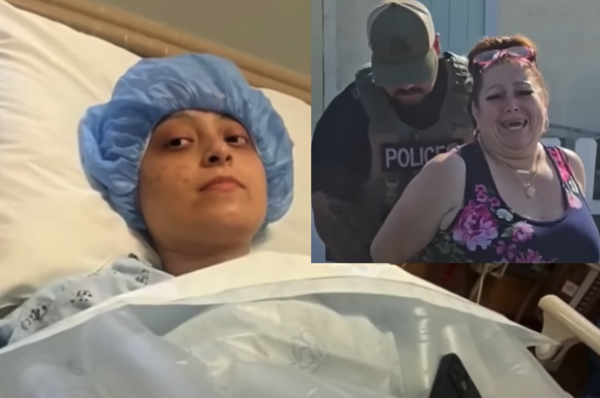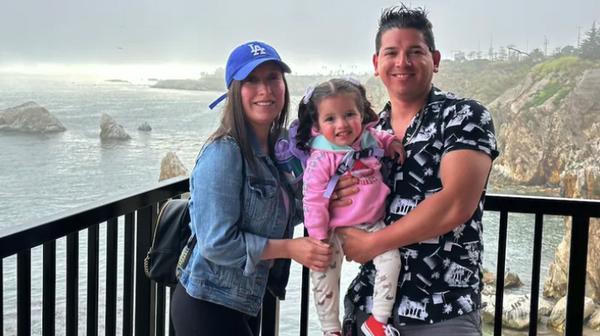CHICAGO — It was the early weeks of the pandemic. A mystery illness was spreading across the Chicago area. And Dr. Sandra McGowan-Watts felt powerless.
She was a family doctor but could do little as her husband and mother-in-law fell ill. Her mother-in-law soon died. Her husband clung to life for a week longer before the virus claimed him too, at age 51.
“I’m a doctor,” she said this month, the pain fresh in her voice. “I’m supposed to be able to fix people and change things, and I can’t even help the person I love the most.”
McGowan-Watts’ husband and mother-in-law joined an early trickle of deaths that soon morphed into massive waves, claiming, collectively, at least 33,000 Illinois lives since the first death was announced just over two years ago.
Even amid shutdowns desperately imposed to limit the infection’s spread, COVID-19 killed at a rate far higher than not just the flu and pneumonia, but surged at times to kill more Illinoisans than cancer or heart disease.
It struck Chicago’s majority-Black and Latino neighborhoods hardest at first before the pandemic saw the first of several shifts — ultimately killing more residents proportionally in Illinois’ southern tip than Chicago.
More contagious variants swept across the state, battling with newly developed vaccines that blunted how much damage each version of the virus could do, at least for those who took the shots. For those who didn’t, the odds of death got far worse at times — creating what public health officials called a “pandemic of the unvaccinated.”
With each new variant and scientific breakthrough, risk calculations have changed. Now, for the younger and boosted, risks of dying from COVID-19 may be less than the risk of dying in a traffic crash, while for those older and unvaccinated, the risks may be exponentially higher.
Into the ever-changing risk calculations are layers of different experiences, as mask mandates are lifted and workers are increasingly asked to return to the office. For some, COVID-19 has been mostly an inconvenience, upending lives but not killing loved ones. For others, the losses include family, friends or neighbors, and shape perceptions of how best to act.
“These experiences are influencing quite significantly the readiness to ‘move on’ from the pandemic,” said Mercedes Carnethon, vice chair of preventive medicine at Northwestern University’s Feinberg School of Medicine.
The losses can be traced to late-winter days two years ago, when a new threat forced daily news conferences from top government leaders, including one that Gov. J.B. Pritzker opened with news he said he “dreaded.”
No flu
In that packed news conference, on March 17, 2020, Pritzker announced the first-known death in Illinois from COVID-19: a retired Chicago nurse.
She’d died the night before, at a time, researchers now say, when testing was scarce and many other early COVID-19 deaths may have been misclassified as other causes, such as flu or pneumonia. (In one case, the Cook County medical examiner’s office last year reclassified the cause of the March 10, 2020, death of an untested Chicago woman, 64, to “probable” COVID-19, after her family said she’d been complaining of a bad flu for weeks, records show.)
Once doctors were able to test those who died of suspicious symptoms, the number of confirmed COVID-19 deaths climbed far beyond typical numbers for flu or pneumonia.
The Centers for Disease Control and Prevention combine flu and pneumonia cases into one category because of similarities. And in the decade before the pandemic, the flu or pneumonia was a main or contributing factor in roughly 2,600 Illinois deaths a year, on average. COVID-19 killed eight times that many in the first year of the pandemic, and nearly five times as many in its second year.
COVID-19′s death tally, during the pandemic’s worst weeks, overtook the biggest causes of death for Illinoisans. By May 2020, more Illinoisans were dying of COVID-19 than either cancer or heart disease, which typically are the leading causes of death.
Among those deaths were McGowan-Watts’ husband and mother-in-law.
`In case I don’t make it’
McGowan-Watts’ mother-in-law lived in a bungalow in the Austin neighborhood and rarely went out. Her son, Steven Watts, McGowan-Watts’ husband and a CTA bus driver, visited his mother regularly — and got sick a day after he brought her to the hospital.
Watts’ mother had asthma and chronic heart disease, and when she started wheezing and having difficulty breathing, she was hospitalized, then intubated. She gave her children her bank passwords, saying, “In case I don’t make it.”
By then, deaths were becoming more widespread in Europe. Watts and his wife watched on television from their Matteson home and worried that they were exposed, but couldn’t get tested immediately.
One day, Watts was strong enough to lift his riding lawn mower to fix it. The next day, he felt pain in his legs, then began suffering from diarrhea, and a fever that wouldn’t break.
Although he had been a relatively healthy 51-year-old, over the next week, he grew gradually weaker, until he was so drained that his wife had to bathe and dress him “like a baby.”
She brought him to the emergency room at South Suburban Hospital, where X-rays showed he had pneumonia in both lungs, and they quickly put him on oxygen. She had never before seen a man with tears in his eyes from struggling to breathe.
He was admitted, and the couple had to say their goodbyes. “I love you,” Watts told her.
For more advanced care, Watts was transferred to Advocate Christ Medical Center in Oak Lawn. The next week was a roller coaster, with her husband fading one day, rallying the next. His wife could visit him online, but not in person.
She begged to see him, but was told it was too dangerous, and they didn’t have enough protective clothing to give visitors. And would her husband want her taking that chance, because if she fell ill, who would take care of their 11-year-old daughter, Justise?
McGowan-Watts did get sick with chills, but only mildly, and quickly recovered. She worked with sick patients in private practice and doing rounds in nursing homes, and worried that she might have been an asymptomatic carrier.
Eventually, her husband suffered kidney failure, then a stroke, and died a week after his mother. One of the nurses taking care of him cried, telling his wife, “This wasn’t supposed to happen. He was going to be our miracle case, because he kept fighting.”
Different surges, different risks
In the first surge of the pandemic, Illinois’ deaths were concentrated in Chicago, and particularly in Black and Latino neighborhoods, such as Austin.
Researchers blamed a host of factors: long-standing health inequities, a higher rate of “essential” jobs that made it harder to isolate, and more intergenerational homes that helped the virus spread. And once it took hold in a community, it could spread quickly.
Three months into the pandemic, Latino Chicagoans had died at twice the rate of white Chicagoans. For Black Chicagoans, the death rate was approaching triple the rate of white Chicagoans.
Carnethon, the Northwestern professor, said the deaths compounded greater economic and educational losses in harder-hit areas, making the pandemic “a very different experience across our communities.”
Beyond that, as nursing homes become inundated, the state found the virus more easily killed in overcrowded facilities that packed three, four or more residents per room — facilities that disproportionately had more Black and Latino residents.
As the first year wore on, researchers and public health officials increasingly warned of deaths that could be sparked from people ignoring health directives, as some people began to take off their masks and mingle indoors, in an atmosphere where enforcement of health rules was spotty, at best. Even before there could be a divide on vaccination, surveys showed a divide in mask-wearing through the pandemic’s first year, with rural residents less likely to mask up.
By March 2021, of the state’s 11 health regions, the highest COVID-19 death rate, adjusting for population differences, was in the 20-county region of Illinois spread from roughly Mount Vernon to Illinois’ southern tip and east to the Indiana line.
That region, by then, saw more than 200 deaths, per 100,000 residents — or nearly double the safest region at the time: one covering Lake and McHenry counties.
To put that in perspective, the Lake-McHenry region, to this day, continues to have a lower overall COVID-19 death rate than the south region had a year ago.
Ultimately, the southern region would tally nearly 1,600 deaths over two years — nearly 1 in every 250 residents, based on 2020 census data — becoming an example of how risks evolved in the pandemic’s second year more to those who didn’t get vaccinated.
Even now — roughly 11 months into mass vaccination — less than half of that region’s residents are considered fully vaccinated (defined as one shot of Johnson & Johnson vaccine, or two shots of Pfizer or Moderna).
Compare that to the most vaccinated region, covering DuPage and Kane counties, where nearly three-fourths of residents are vaccinated. Since mid-April 2021, when mass vaccination took hold, residents in the south region have been three times as likely to die of COVID-19 as residents in the DuPage-Kane region.
Another way to look at it: If every other region in Illinois had experienced the same rate of death as the south region, nearly 17,000 more Illinoisans would have died by now.
Vaccinations likely helped Illinois fare better in the second year of the pandemic, compared to its five neighboring states, which all have lower vaccination rates.
Before mass vaccination, Illinois had the second-highest death rate from COVID-19. Only Indiana’s was worst.
But in the period after mass vaccination began, Illinois’ death rate has been the lowest of any of its neighbors.
Adjusting to a new normal
As vaccinations took hold and lessened death tallies, survivors have been left to try to mourn in their own way.
For McGowan-Watts and her family, they couldn’t have a funeral for Watts or his mother — nor visits or even hugs. A joint memorial was later held at the Oak Park Conservatory, but attendance was limited to 50 people, as mandated at the time.
Along the way friends and family showed support by bringing food, or helping to clear snow or, later, cut grass for McGowan-Watts and her daughter.
They both went to counseling. Justise also went to a grief camp in Michigan that summer, where she was able to talk about her feelings with other kids who had lost family members.
At home, she stepped up to make dinners and help with other home duties. Cooking became a form of therapy for the teen. She found some of her father’s and grandmother’s recipes, and gives cooking demonstrations on Facebook.
Her mother struggled with her own issues. After such a traumatic experience, McGowan-Watts lost 20 to 30 pounds, unable to sleep or eat. Slowly she regained her footing, and by now, she said, she is able to talk about her experience in order to help others.
“It’s been hard for everybody,” McGowan-Watts said. “But we have gotten closer as a family.”
As families have mourned and tried to move on, the pandemic has evolved. After a particularly deadly omicron wave, deaths and hospitalizations have plunged. New treatments are making it easier for those seriously ill to survive. Masks are largely coming off.
For those vaccinated, particularly boosted and younger, the latest calculated odds of dying from COVID-19 were, as of late December, as low or lower than from dying in a traffic crash. But for those older and unvaccinated, even before the peak of omicron, the odds of a COVID-19 death were far worse.
Researchers expect a resurgence at some point, although it’s hard to predict when and how bad. And deaths aren’t the only cause for concern. Hospitals can still become clogged with coronavirus patients, threatening the quality of treatment not just for them, but for anyone else needing critical care.
From her family practice office in Flossmoor, McGowan-Watts has tried to do her part to save lives.
She’s convinced many reluctant patients to get the shots. Some got sick anyway over the winter, but had mild cases, while some of those who didn’t get the shot were hospitalized, or worse.
She shares her family’s story — one of tens of thousands across Illinois — and tells them, from personal experience: “This is no joke.”
———







